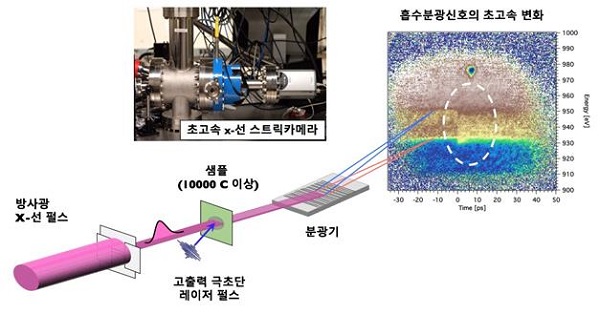Media Center
A multimedia mosaic of moments at GIST
GIST Excellence
[Press Release] Professor Byoung-ick Cho leads an international team of researchers to successfully investigate the electron heat capacity and the electron-ion relaxation of copper in warm and dense conditions
- 엘리스 리
- REG_DATE : 2016.01.18
- HIT : 742
Professor Byoung-ick Cho leads an international team of researchers to successfully investigate the electron heat capacity and the electron-ion
relaxation of copper in warm and dense conditions
Results published in Nature"s Scientific Reports

(Figure 1.) Schematic of the experimental set-up. The femtosecond optical pulse is focused on the sample to provide 0.32 ~ 0.6 J/cm2 absorption fluence. The broadband x-ray beam (900 ~ 1,000 eV) from the ALS undulator is overlapped with the optical laser pulse on the sample.
Warm dense matter (WDM) is the state between condensed matter and plasma and is naturally produced under conditions of extreme temperature and pressure, such as are found inside of stars and large planets. Creating WDM artificially usually requires the uniform rapid bulk heating of a solid to plasma phase, as can be achieved by using intense laser pulses. Studying WDM is important for understanding phase transition and the energy relaxation processes that are experienced when condensed matter transitions to plasma under extreme conditions.
Unfortunately, studying WDM is inherently difficult because of its extreme temperature and pressure conditions as well as by the complicated physical interactions found within the WDM. Usually, for strongly heated fluid or plasma systems, the energy relaxation processes are modeled through direct two-particle scattering or ion acoustic modes. However, these models generally give relaxation times that are much longer than earlier predictions. Other issues include the assumption of the electron density-of-states as well as the lack of consideration for the distribution of non-equilibrium electrons. To overcome these issues, direct measurement of the WDM"s thermodynamic properties are required.
GIST Professor Byoung-ick Cho of the Department of Physics and Photon Sciences and the Center for Relativistic Laser Science (Institute for Basic Science) has led an international team of researchers to successfully investigate the electron heat capacity and the electron-ion relaxation of copper in warm and dense conditions by using a femto-second laser pump - picosecond x-ray probe technique. The electron heat capacity and electron-ion relaxation were determined from the initial electron temperatures and their decrements. Comparisons with the thermal properties of ambient copper and various theoretical predictions confirmed that these properties are sensitive to electron temperature and details of electronic structure. Both quantities exhibited the best agreement with the calculations including high temperature electron distributions and the liquid density of state.
The results of this investigation were published in a paper entitled "Measurement of Electron-Ion Relaxation in Warm Dense Copper," which was authored by B.I. Cho, T. Ogitsu, K. Engelhorn, A.A. Correa, Y. Ping, J.W. Lee, L.J. Bae, D. Prendergast, R.W. Falcone, and P. A. Heimann and published in Nature"s Scientific Report on January 6, 2016. This research was supported by the Institute for Basic Science and the National Research Foundation of Korea. Portions of this research were performed at Lawrence Berkeley National Laboratory under the auspices of the U.S. Department of Energy, Office of Science, Basic Energy Sciences, Materials Sciences Division. The work at Lawrence Livermore National Laboratory was performed under the auspices the U.S. Department of Energy. Several researchers were also supported by DOE HEDLP program.

(Figure 2). Image 1 shows the electron heat capacity at around 20,000 K (red hexagon). Electron heat capacities calculated based on WDM, solid DOS and free electron model. Ion heat capacity vs. temperature (blue square) at around 10,000 K is also determined. Image 2 shows G obtained by Eq. (1) at 2, 4 and 6 ps for three different energy densities are displayed at the corresponding electron temperatures together with electronphonon coupling calculations using Eq. (2) with both liquid DOS and ambient solid DOS. For comparison, the electron-phonon coupling constant of solid Cu is also shown. The picture is of Professor Byoung-ick Cho.
Professor Byoung-Ick Cho said, "This research will yield news methods for studying the physical properties of materials under extreme conditions. Furthermore, this research will give us a basis for better understanding the formative processes of iron and nickel within the center of planets and will contribute to the development of new materials, such as ultra-dense super diamonds."